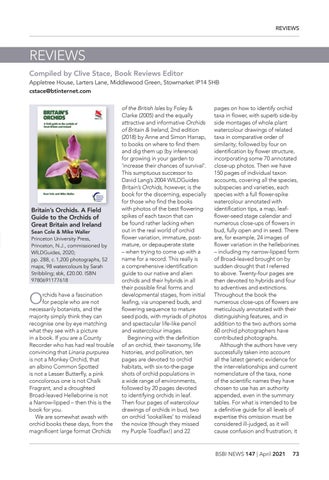REVIEWS
REVIEWS Compiled by Clive Stace, Book Reviews Editor Appletree House, Larters Lane, Middlewood Green, Stowmarket IP14 5HB cstace@btinternet.com
Britain’s Orchids. A Field Guide to the Orchids of Great Britain and Ireland
Sean Cole & Mike Waller Princeton University Press, Princeton, N.J., commissioned by WILDGuides, 2020; pp. 288, c. 1,200 photographs, 52 maps, 98 watercolours by Sarah Stribbling; sbk, £20.00. ISBN 9780691177618
O
rchids have a fascination for people who are not necessarily botanists, and the majority simply think they can recognise one by eye matching what they see with a picture in a book. If you are a County Recorder who has had real trouble convincing that Linaria purpurea is not a Monkey Orchid, that an albino Common Spotted isnotaLesserButtery,apink concolorous one is not Chalk Fragrant, and a droughted Broad-leaved Helleborine is not a Narrow-lipped – then this is the book for you. We are somewhat awash with orchid books these days, from the magnicentlargeformat Orchids
of the British Isles by Foley & pages on how to identify orchid Clarke (2005) and the equally taxainower,withsuperbside-by attractive and informative Orchids side montages of whole plant of Britain & Ireland, 2nd edition watercolour drawings of related (2018) by Anne and Simon Harrap, taxaincomparativeorderof tobooksonwheretondthem similarity; followed by four on and dig them up (by inference) identicationbyowerstructure, for growing in your garden to incorporating some 70 annotated ‘increase their chances of survival’. close-up photos. Then we have This sumptuous successor to pages 051 ofindividualtaxon David Lang’s 2004 WILDGuides accounts, covering all the species, Britain’s Orchids, however, is the subspecies and varieties, each book for the discerning, especially specieswithafullower-spike forthosewhondthebooks watercolour annotated with withphotosofthebestoweringidenticationtips,amap,leafspikesofeachtaxonthatcan ower-seedstagecalendarand be found rather lacking when numerousclose-upsofowersin out in the real world of orchid bud, fully open and in seed. There owervariation,immature,postare,forexample,images 42 of mature, or depauperate state owervariationinthehelleborines – when trying to come up with a – including my narrow-lipped form name for a record. This really is of Broad-leaved brought on by acomprehensiveidenticationsudden drought that I referred guide to our native and alien to above. Twenty-four pages are orchids and their hybrids in all then devoted to hybrids and four theirpossiblenalformsand toadventivesandextinctions. developmental stages, from initial Throughout the book the leang,viaunopenedbuds,and numerousclose-upsofowersare oweringsequencetomature meticulously annotated with their seed pods, with myriads of photos distinguishing features, and in and spectacular life-like pencil addition to the two authors some and watercolour images. 60 orchid photographers have Beginningwiththedenition contributed photographs. ofanorchid,theirtaxonomy,life Although the authors have very histories, and pollination, ten successfully taken into account pages are devoted to orchid all the latest genetic evidence for habitats,withsix-to-the-page the inter-relationships and current shots of orchid populations in nomenclatureofthetaxa,none a wide range of environments, ofthescienticnamestheyhave followed by 20 pages devoted chosen to use has an authority to identifying orchids in leaf. appended, even in the summary Then four pages of watercolour tables. For what is intended to be drawings of orchids in bud, two adenitiveguideforalllevelsof on orchid ‘lookalikes’ to mislead expertisethisomissionmustbe the novice (though they missed considered ill-judged, as it will myPurpleToadax!and ) 2 cause confusion and frustration; it
BSBI NEWS 147 | April 2021
73
















